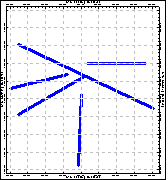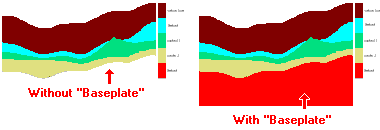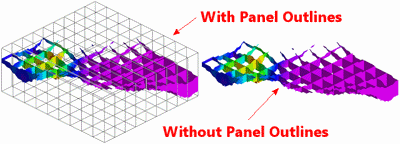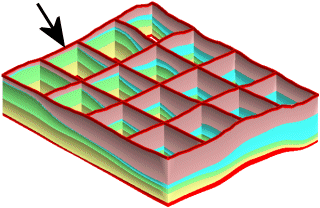
RockWorks | Borehole Operations | Stratigraphy | Fence | Model-Based
Use this program to:
- Interpolate grid models for the upper and lower surfaces of the project's stratigraphic units (all units or selected ones)
- OR -
Read grid models that you've already created,
- "Slice" these grid models along multiple panels. Because surfaces are interpolated across the entire project, you can place the fence panels anywhere you like. You may request regular fence panel spacing, in a variety of configurations, or you can draw your own panels.
- Display the fence diagram in RockPlot3D. The layers will be color-coded based on the formation's background color in the Stratigraphy Types Table.
See also:
Hole to Hole Stratigraphic Fence Diagrams for fence diagrams drawn with linear correlations (not grid-based)
What is an Interpolated Fence
Manually Building 3D Stratigraphic Fences for building diagrams from existing grid models (filtered, imported, etc.)
Feature Level: RockWorks Standard and higher
Menu Options
Step-by-Step Summary
- Rules & Filters: Use the buttons at the top of the window to apply filters and rules for this program. (More info)
- Spatial Filter: Filter the input data for the stratigraphy model based on XYZ location, filter the data to be displayed in striplogs, if activated. Note that these tools filter the data that is passed to the modeling and log-generating procedures. This is distinct from the filters that are applied once the model is completed, and described below.
- Time Filter: Filter any T-Data or Aquifer data in striplogs, if activated.
- Stratigraphic Rules: Apply stratigraphy rules for interpolating the grid surfaces and for display of stratigraphy data in striplogs, if activated.
- 3D Log Design
Click here to choose which data items are to be displayed in the logs, if activated via the Striplogs checkbox below, and in which order. See Using the 3D Log Designer and the Visible Item Summary.
- Fence Location
Click on this button at the top of the window to draw, on a map display of your enabled boreholes, where the fence panels are to be placed. The most recent fence drawn for this project will be displayed (More info)
- Location Map
Insert a check in this tab, at the top of the window, to create, along with the fence diagram, a reference map that shows the fence panel locations.
Click on this tab to set up the map options. (More info)
-

- Stratigraphic Units
Click this tab to define which of your formations are to be included in the modeling and display. (More info)
- All Stratigraphic Units: Choose this if all units are to be modeled (if Interpolate Surfaces is checked, below) and displayed in the 3D diagram.
- Only Units Flagged As "Show In Legend": You can limit the interpolation (Interpolate Surfaces checked) and display to only those formations with a check in the Show in Legend check-box, in the Stratigraphy Types table.
 Interpolate Surfaces: When this option is checked, the program will interpolate grid models for the top and bottom of all/selected stratigraphic units (as specified above).
Interpolate Surfaces: When this option is checked, the program will interpolate grid models for the top and bottom of all/selected stratigraphic units (as specified above).
 Interpolate Surfaces: When this option is not checked the program will assume that the grids already exist, from a previous pass with a Stratigraphy menu option, from making custom edits to the grids, from importing them from another source, etc. In other words, you may not want to create new grid models every time that you generate a diagram.
Interpolate Surfaces: When this option is not checked the program will assume that the grids already exist, from a previous pass with a Stratigraphy menu option, from making custom edits to the grids, from importing them from another source, etc. In other words, you may not want to create new grid models every time that you generate a diagram.
! IMPORTANT NOTE: The existing grid models must follow the automatic naming scheme: Models for formation tops are named formation_top.RwGrd and those for formation bases are named formation_base.RwGrd, where formation is the exact name of the formation as defined in the Stratigraphy Types Table. The program will assume these grids exist if Interpolate Surfaces is turned off.
Options: If you have Interpolate Surfaces turned ON, click the Interpolate Surfaces tab to set up the modeling options in the tabs to the right.
- Gridding Method: On this tab you can establish the gridding method, the grid dimensions, and other gridding options.
- Dimensions: Use this tab to specify how the grid dimensions are to be established. Unless there's a specific reason to do otherwise, you should probably leave the grid dimensions set to the current project dimensions.
- Algorithms: Select a gridding method for the interpolation of the surfaces.
- Options: Establish the other general gridding options (declustering, logarithmic, high fidelity, etc.).
- Modeling Sequence: Click on this tab to tell RockWorks whether the formations are to be modeled as entered, from the base upward, or from the top down.
- None: Choose this option to model the formations based on the data as entered, with any applicable rules you have activated.
- Base-to-Top (Onlap): Click in this option to "fix" stratigraphic models in which portions of an upper unit extend below the base of a lower unit. The program will give lower units "priority," building model from the bottom-up.(More.)
- Top-to-Base (Underlap): Choose this option to give priority to upper units instead. Any portions of lower units which extend above the base of an upper unit will be constrained to the base of that unit. (More.)
- Constraining Surface: Insert a check here if you want the stratigraphy model to be filtered with a surface, typically representing the ground surface.
! This model must have the same dimensions and node spacing as is represented in the stratigraphy model surfaces. If you need to resample the ground surface grid, refer to the ModOps Grid | Math | Resample option. Click to the right to specify the name of the ground surface grid model (.RwGrd) and the filtering direction. (More info)
- Polygon Filter: Activate this option to remove portions of the stratigraphic surfaces that lie either the inside or outside of a user-defined polygon. (More info)
- Baseplate: Check this option if you want the base of the lowest formation to be extended down to a set elevation. This is helpful for data sets missing depth-to-base values in the lowest formation (boreholes never reach the bottom). (More.)
-

- Smoothing Passes: Use this to define how many times the stratigraphic contacts should be smoothed. Enter "0" for no smoothing, "1" for slight smoothing, "2" for more smoothing, etc. Note that there is a paradox here: If you smooth the contacts, the diagrams will look more aesthetically pleasing, but the contacts may not exactly match up at intersection points between the panels.
- Truncate: Check this box to limit the fence diagram to a specific elevation range. For example, if you have stratigraphic data from -1000 to -3500 (subsea) feet in elevation, but you only want to see the units from -2000 to -2500, you would enter "-2000" for the top elevation and "-2500" for the base.
- Top Elevation: Click here to type in the uppermost elevation to include in the fence.
- Base Elevation: Click here to type in the lowermost elevation to include in the fence.
- Panel Borders
Check this box to include a solid-line outline around each fence panel.
Click on this tab to define the line style and color.
-

- Surface Profile
Insert a check here to include a solid line profile on each fence panel that represents a user-selected grid model, such as a water level surface or the ground surface.
Click on this tab to select the grid model to be represented in the fence diagram, and to establish the profile settings. (More info)
-

- Striplogs
Check this item to include 3D logs with the stratigraphy fence display. Note that 3D logs for all active boreholes will be appended to the fence diagram.
Click the 3D Log Design button at the top of the window to set up how you want the logs to look.
Click on this tab to establish some additional striplog settings.
- Clipping Dimensions: Insert a check in the X, Y, and/or Z axis options if you want to restrict the logs to a particular spatial area. (More info)
-

- Other 3D Diagram Options: Use these checkboxes to append other layers to your 3D scene. (Summary)
- Draped Image: Include an image in this 3D scene, draped over an existing grid surface. (More info)
- Floating Image: Include an image in this 3D scene, floating at a specified elevation. (More info)
- Perimeter Cage Include a 3D reference cage around the fence diagram. (More info)
- Legends: Include one or more legends with the diagram.(More info)
- Infrastructure: Display buildings, pipes, or other infrastructure with your 3D scene. (More info)
- Faults: Include 3D fault ribbons with this scene. (More info)
- Other 3D Files: Include other, existing, RockPlot3D ".Rw3D" files in this scene. (More info)
- Output Options: Use these settings to define whether the output scene is to be displayed after it is created and how/whether it is to be saved in the project folder. (More info)
Follow these steps to create a 3D fence diagram illustrating grid-based stratigraphic layers, for display in RockPlot3D:
- Access the RockWorks Borehole Manager program tab.
- Enter/import your data into the Borehole Manager database if you have not already done so. This tool specifically reads location, orientation (if any), and stratigraphy data. You might also refer to the Missing Formations section regarding the best way to deal with including/not including absent formations.
- Enable boreholes: Be sure that all boreholes whose data are to be included in the stratigraphy model (which will be sliced for the fence diagram) are enabled.
- Select the Borehole Operations | Stratigraphy | Fence | Model-Based menu option.
- Enter the requested program settings, described above
- If you are including logs, be sure to click on the 3D Log Design button at the top of the window to establish how you want the logs to look.
- Click on the Fence Location button (top of window) to select the fence panel locations.
- Click on the Continue button to create the Stratigraphy fence diagram.
If Interpolate Surfaces is turned on, the program will create grid models of the surfaces and bases of the formations listed in the Stratigraphy table, storing the models in the current project folder. The grid file names are assigned automatically, based on the formation: "formation_top.RwGrd" and "formation_base.RwGrd". Two grid models will be created for each formation using the specified gridding settings.
It will then look at the coordinates specified for each fence panel and determine the closest nodes along the cut in each grid model. It will construct a vertical profile to illustrate the stratigraphic elevations, using the background colors defined for the strata in the Stratigraphy Types Table. This process will be repeated for each fence panel you drew. If requested, logs and other diagram layers will be appended. The completed scene will be displayed in a RockPlot3D tab in the Options window, if requested.
- You can adjust any of program settings in the Options tab and click the Continue button again to regenerate the fence diagram.
! * If the stratigraphy surfaces look OK and you just need to adjust one of the diagram settings, you don't need to keep re-gridding over and over: Un-check Interpolate Surfaces and the fence will be built with the new diagram settings from the existing grid models.
- View / save / manipulate / print / export the fence in the RockPlot3D window.
Unlike lithology, geochemistry, and geophysical fence diagrams, which are built as vertical panels extracted from a solid model, modeled stratigraphic fences are displayed simply as pieces of the stratigraphic surface models. For this reason, you can expand the data tree in the RockPlot3D window and turn on/off entire formations in the fence display.
 Back to Stratigraphy Menu Summary
Back to Stratigraphy Menu Summary

RockWare home page







![]() Back to Stratigraphy Menu Summary
Back to Stratigraphy Menu Summary